
The Cane Corso is a breed of exceptional tenacity, and that much is obvious simply by looking at the dog.
Nothing seems capable of harming this gentle giant.
The health of the healthiest dog (or person) is no more immune to illness than that of any other dog or human. This in no way indicates that they are weak or ill. If a Cane Corso is examined regularly, its owners will be able to see and deal with health problems early on.
As every dog owner knows, it breaks your heart to see your pet in pain.
Dogs can’t understand why they need to take their meds, therefore we humans must shoulder the responsibility of making sure they do. The secret to a happy and healthy pet is in knowing what steps to take.
Cane Corsos had a varied and eventful history, from hunting wild boar to becoming one of the most sought-after security dogs. At the very least, we can guarantee these big dogs with big hearts a long and happy life right now.
The Cane Corso’s Health Problems Are Best Treated When They Are Discovered in the Puppy Stage

The Cane Corso, like other dogs, is susceptible to a range of illnesses that are symptomatic of its breed. If this is your first time buying a home, you need to be ready for anything.
Some of the most prevalent health problems in dogs include their joints, skin, and nervous system, and their unusual anatomy makes them more prone to vision difficulties.
You want to be informed because, as the old adage goes, “knowledge is power.”
If you’re searching for a rundown of chronic diseases and ailments experienced by the Cane Corso, we’ve got you covered.
We will spend some time getting to know the CC in depth, so don’t worry if you don’t know much about them now.
I was wondering whether Cane Corsos were healthy dogs
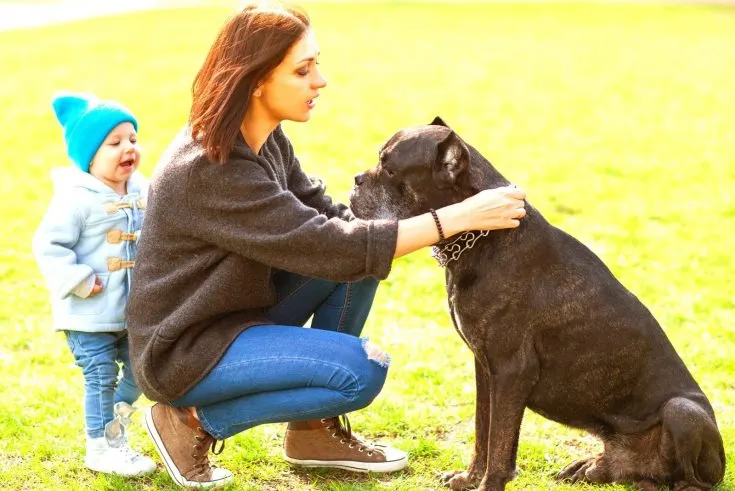
YES. The Cane Corso was effectively brought back from the verge of extinction via careful, recent breeding using cutting-edge genetics research.
As a result, the Cane Corso has a low susceptibility to genetic disorders. This is one tough pooch… That thing is a powerful soldier, quite at home in the Roman army.
Although powerful and self-assured, they will only reach their full potential with a strong hand and extensive socializing.
This breed originated from Molossia dogs, which were used as battle dogs and guard dogs by the Ancient Romans.
In spite of its long history and widespread distribution over the Italian peninsula, the American Kennel Club (AKC) didn’t officially recognize the breed until 2010!
By the time the Cane Corso was fully developed, the world had already heard of this powerful Imperial Mastiff and its devoted fan base.
What are the most common health concerns for a Cane Corso?
Nothing out of the ordinary; simply the usual difficulties such as large-breed-specific hip dysplasia, bred-out neurological disorders, ocular anomalies, and annoying mites.
The only way to guarantee that a Cane Corso puppy you purchase is healthy, well-adjusted, and suitable for breeding is to get it from a reputable breeder. Breeding irresponsibly has negative effects on both dogs and their owners, and it slows down efforts to eradicate hereditary problems in the breed.
Your dog’s file will include any ailments or medical procedures your dog has had, which might decrease its show score or render it unable to have pedigree pups.
Bone and connective tissue problems in the Cane Corso:

These canine giants, known as Corsi, tower above the average dog in the park.
This makes them more likely to experience bone and joint wear and tear as the pressure of their body weight wears down the skeleton’s supporting tissues.
Cane Corsos often have the following bone problems:
Dysplasia of the hip
Dogs might suffer from hip dysplasia if the top of the thigh bone isn’t properly seated in its socket.
Large-breed dogs are more susceptible, and the condition may be diagnosed after the puppy has matured. Hip dysplasia is a degenerative condition that affects the hip joint; affected dogs frequently have weak cartilage from birth, and as the tissue wears away, the ball end of the joint dislocates from the socket.
Some of the most common causes of this condition are a dog’s weight, its inability to exercise, and the dog’s joints simply not keeping up with its rapid rate of development.
Although younger canines are not immune, older dogs are more often affected.
When purchasing a Cane Corso from a breeder, it is imperative that you insist on seeing OFA and PennHIPP certifications.
What Are the Signs That My Cane Corso May Have Hip Dysplasia?
It’s possible that your dog has hip dysplasia if it seems stiff, sluggish, or ‘rabbit hops’ while favoring its front legs.
Your dog is likely to experience a significant lot of distress due to the excruciating discomfort of this situation.
Your dog will develop a limp and have muscular atrophy in its hind legs as a result of this.
Since it is thought to be inherited, it’s important to bring up with the breeder before bringing home a Cane Corso puppy.
How Can Hip Dysplasia Be Treated?
Surgery is the gold standard for fixing this problem.
This may be done in a few various ways, including by realigning the pelvis, by cutting off a section of the femur, or by getting a new hip completely.
Based on your puppy’s medical history, your licensed vet will decide what treatment is best.
Even if you don’t regularly use it, pet insurance might be helpful in this situation. This is a common procedure in veterinary medicine, so a trained surgeon can fix the issue for good.
If left untreated, secondary Osteoarthritis may develop, therefore it’s best to get on it as soon as you notice any symptoms.
While osteoarthritis won’t kill your dog, it will severely diminish his or her quality of life
This is the most common kind of arthritis in dogs. Over a quarter of all canines are thought to be affected by this disease.
Osteoarthritis is a joint condition characterized by the gradual degeneration of cartilage and the subsequent replacement of that lubricating tissue by bone, leading to a thickening of the joint capsule.
Because of this, the injured limb becomes limp and eventually immobile.
Hip and elbow dysplasia, dislocations, and other main disorders might contribute to the condition.
Obesity and other forms of lifestyle abnormality have been linked to the development of this problem.
How can I determine whether my Cane Corso has osteoarthritis?
Medical imaging techniques like X-rays and MRIs may help vets identify osteoarthritis in dogs.
In addition to the dog’s limp, a hard, immovable lump may sometimes be seen in the joint as further evidence of this condition.
While the veterinarian may have a good idea that this is the case without running any tests at all due to the disease’s prevalence and the fact that it is easily seen and felt with the naked eye, a definitive diagnosis requires that tests be performed.
The initial signs of canine arthritis include a change in stride, muttering and moaning in pain when the dog walks, or aloofness and disinterest.
How can we fix this problem?
The first order of business is to pick yourself up!
It’s not the end of the world if your dog is diagnosed with osteoarthritis. You can still have a wonderful, successful life together.
Osteoarthritis currently has no treatment available. Although this may seem bleak, remember that millions of individuals throughout the globe are fighting this disease every day.
It may afflict up to 20% of the world’s canines, and is seen at an alarmingly high rate in dogs with joint dysplasia.
One of the most important things you can do for your dog is to be sensitive to his or her emotions. Any dog worth its paws will place a premium on speed and fitness. They could be shocked or confused if time suddenly slows down for no apparent reason. That’s why it’s so crucial to ensure your dog always feels secure and loved.
If you think your dog is in discomfort, talk to your vet about giving him pain medication. Pain relievers, particularly those designed for humans, may be very harmful to dogs, so it’s crucial that you adhere to the dose instructions given by your doctor.
Gastrointestinal Cane Corso Health Issues:
Knowing how simple it is to ignore the signals of abdominal problems and how fast they may get out of hand makes them a major worry of mine.
No matter how intelligent your dog is, there will always be times when it does something silly, like eat something it shouldn’t or harm itself accidentally.
The following illness may strike any dog at any time for no apparent reason.
If your dog has the misfortune of contracting this illness, you should be aware of the situation.
The First Cause of Obesity in Dogs Is Bloat, or Gastric Torsion
Bloat, or stomach dilatation volvulus, is the worst-case scenario for any pet owner. This is a life-threatening emergency that requires quick attention.
It’s caused by the organs shifting about in the dog’s stomach, which is quite painful for the dog.
Your Cane may be susceptible to bloat because of his deep chest and narrow tummy.
The actual origins of this deadly illness remain unknown to experts.
Your dog may do this if he or she is anxious, which may lead them to swallow air, or if they eat gassy, unusual foods.
This is why it’s so important to give your dog only dog food that has been specifically formulated to meet all of its nutritional demands without causing any unwanted side effects, including bloat.
Recognizing and Treating Gastric Torsion
Anxiety, apathy, an unwillingness to eat, and rapid, shallow breathing are some of the less obvious symptoms.
Check for stiffness or tightness in your dog’s stomach by touching its middle. Do you get the impression that it’s just air?
When you pet your dog, does it twitch or wince?
If you suspect that your dog has stomach torsion, don’t delay in taking him to a licensed veterinarian.
It may soon get out of hand if not addressed, causing necrosis of the stomach and then sepsis and infection.
Do not panic if it is judged that surgical intervention is necessary for your dog; the procedure is simple, fast, and very successful.
Your veterinarian will either make a tiny incision in your dog’s stomach or implant a tube into its mouth that goes all the way to its stomach to drain the air out, depending on how severe the case is.
If treated quickly, this has an excellent prognosis, but your dog will need to spend at least 48 hours in the hospital.
Cherry Eye: It’s Painful And It Looks Ugly
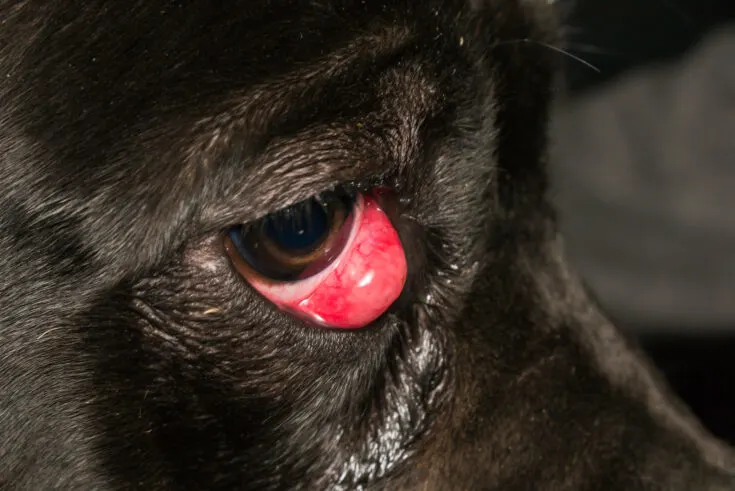
This eye condition, one of the most common among Cane Corsos, manifests itself clinically as red, projecting bulges at the canine’s eye corners.
Caused by irritation of the nictitating membrane (the “third eyelid”) at the point where the upper and lower eyelids meet, this condition affects vision.
The tear duct becomes swollen and the condition takes on its signature look as a result.
Although it poses no immediate threat, it is very annoying and unattractive.
Even if this causes you to rush your dog to the emergency room, be assured that he or she is likely to be alright.
There Are Many Reasons You Should Avoid Having Cherry Eye in Your Cane Corso:
Cherry eye isn’t very dangerous and can be treated with eye drops, but if it’s left untreated, it may lead to more significant issues including conjunctivitis, vision loss, corneal damage from scratching, and so on.
Since the cherry eye is thought to be linked to the form of the dog’s head, the Cane Corso is predisposed to getting the condition.
If it turns out that the disease is hereditary and exacerbated by the animal’s massive size, surgical removal may be the only option. If you care about your dog’s quality of life, you should do this.
In most cases, it only affects canines under 2 years old.
Ectropion-Prone: Is Surgery Necessary?
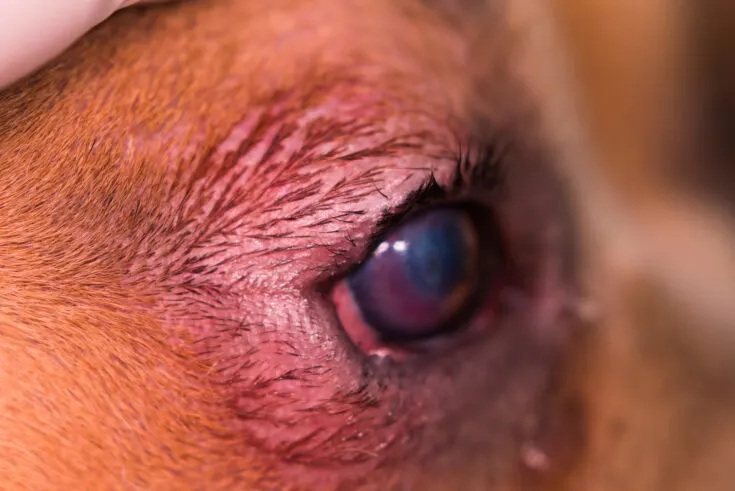
When a dog has ectropion, his or her eyelid turns inward, exposing the delicate inner eyelid and leading to a host of complications.
A variety of dog breeds, including the Cane Corso, St. Bernard, the Italian Mastiff, the Shar Pei, the Newfoundland, and several spaniel types, are predisposed to this condition because of their droopy facial form.
Learn What Ectropion Looks Like Once You See It
There are a few telltale signs of the condition, and these include:
- Redness and inflammation of the conjunctiva, the inner membrane of the eye, caused by the drooping of the lower eyelid.
- The persistent, dark trail of tears that never fill the tear ducts.
- Causes swelling.
- Recurrent eye irritation caused by a bacterial infection or itchy eyes from scratching.
- Multiple, independent elements have been identified as its root causes.
Primary means that it is mostly hereditary, and that the dog’s face is not growing normally. The Cane Corso breed is particularly prone to this.
Only surgical correction can fix primary ectropion.
The costs associated with removing this cosmetic defect should be covered by your pet insurance policy.
Many conditions, such as hyperthyroidism, facial paralysis, significant weight loss, and bacterial or trauma-related corneal ulcers, may lead to secondary ectropion.
To alleviate the discomfort, lubricants are used, and antibiotics are sometimes used to treat the underlying infection.
Does Entropion Happen in Cane Corsos? What Makes This One Different?
In this condition, the eyelid turns inside instead of outward, and the eyelashes rub the cornea.
For snub-nosed, sagging-skinned, and enormous breeds, this is the “dominant” coat type.
Here’s where the Cane Corso comes in handy, obviously. Some types of retrievers and setters are prone to this as well.
This often occurs because the ligaments that support the eyelids are very big in these dogs.
Scarring of the eyelids, nerve damage, the loss of facial muscles, and infection are the most prevalent causes of the “secondary” variety.
Entropion will improve with general health if the underlying cause is addressed.
Entropion is associated with corneal ulceration, a painful eye irritation.
Discovering Congealed Mucus in a Cane Corso’s Eyes
Cane Corso entropion symptoms are readily apparent.
Your dog’s fast blinking, red and/or inflamed eyes, and the presence of greenish-yellow mucus in the eye corners will give it away.
Dogs with entropion are easy targets for veterinarians who may also perform a corneal ulceration test.
Entropion should be examined for in young puppies who have problems opening their eyes.
In large dogs like the Cane Corso, surgery is usually the first line of treatment.
Such surgery is never done on pups, at least not until their permanent facial features have been established.
The problem is temporarily resolved by repositioning the protruding sac and closing the skin with stitches.
All of these visual problems in Cane Corsos tend to run in families, and they are not unique to the breed. These problems originate from the unique structure of the breed’s skull.
Many other types of Mastiffs and droopy-faced dogs are also susceptible to them, including the Shar Pei, the Bulldog breeds, certain varieties of the Spaniel, and even the Labrador and Labrador Retriever.
An Itchy, Scratchy Term For Demodex
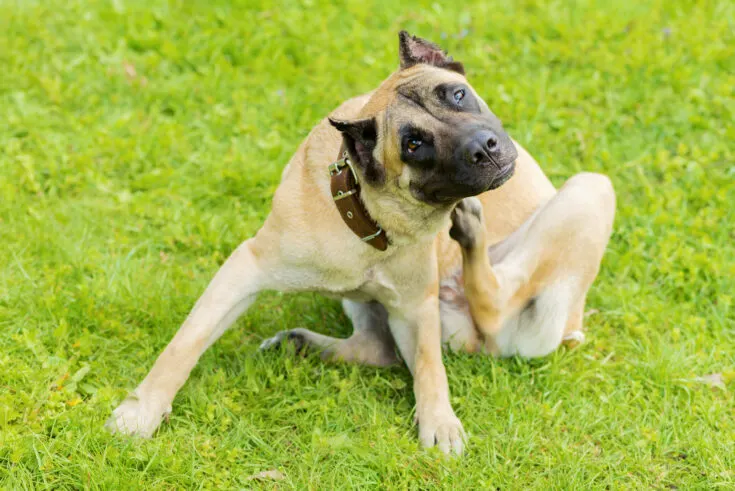
As a skin disease, mange affects a large percentage of canine populations.
Demodex mites, which are present on a dog’s skin and fur, are to blame.
Although both types of mange are brought on by the same pest, sarcoptic mange and demodectic mange are distinguished by whether the mites target the skin or the hair follicles.
One form spreads to other dogs via faulty immune systems, while the other may strike any dog that happens to be infected.
The illness is difficult to eradicate completely due to its tenacious nature.
Demodectic Mange: A Perpetual Source of Discomfort
It’s the more frequent of the two, and it goes by many names.
This form specifically attacks the hair follicle, resulting in the Cane Corso’s fur falling off in clumps.
Symbiotically, your dog’s body provides a home for the mites that inhabit its hair.
Typically, they provide more good than damage, and they go about their business without drawing attention to themselves. Dogs with compromised immune systems are particularly at risk from the proliferation of mites.
The facial manifestation of the condition is common.
Manage could seem to be heritable since the underlying immune system issue is likely hereditary.
If you’re getting a Cane Corso puppy from a reputable breeder, the odds are low that either of its parents had mange.
It may be localized or systemic, and it produces symptoms including itching, burning, and redness of the skin, as well as hair loss that often starts on the face.
Dipping Dogs: What Can I Do About Demodectic Mange?
Multiple complementary therapies are used to treat demodectic mange. To put it plainly, you have to throw the kitchen sink at the ants.
- Topical creams and shampoos.
- “Dipping,” or swimming in a particular dip containing Amitraz and other medications, is used for therapeutic purposes.
- Oral insecticides are commonly used off-label to treat mange even though it has not been authorized by the FDA.
- Steroid injections — to minimize the swelling and pain produced by mite bites.
It’s not fatal, but it may severely reduce your dog’s quality of life, which is why infected dogs aren’t kept for breeding.
In contrast to Common Scabies, Sarcoptic Mange Is Completely Unique… In a sense
Parasitic Demodex mites in this form of the disease cause itching and irritation by burrowing into the skin of the host. The Cane Corso’s short coat makes it easy to see any changes in the dog’s skin and coat.
Cane Corso shedding may be exacerbated by this disease.
The hair loss occurs in patches because the dog scratches and gnaws at the affected areas.
If you see a mangy dog on the sidewalk or at the dog park, you should immediately leave the area.
Your Cane Corso is a potential vector for this zoonotic illness, meaning it might spread to humans and other canines.
A board-certified veterinarian is the best person to treat this problem using custom-formulated dips and topicals.
There is a wide variety of oral drugs to choose from.
Ear Infections Can Trouble Clipped Dogs:
Due to the fact that many Cane Corso owners choose to have their dogs’ ears clipped, this breed is prone to ear infections. It often manifests itself in a dog’s early years. This increases the likelihood of a middle ear infection in such a huge breed.
If you see any redness or swelling in your dog’s ears, it’s time to take action.
Look for signs of mucous, bad smells, and inflammation. In an anxious state, your dog may wag its tail, shake its head, and scratch or push its ears against the walls or upholstery. Disorientation, hearing loss, and eye twitching are among symptoms that may manifest in more severe instances.
A severe ear infection is unusual yet possible. After cleaning and medication, the condition usually improves.
Learn to Spot the Telltale Signs of Epilepsy in Your Cane Corso
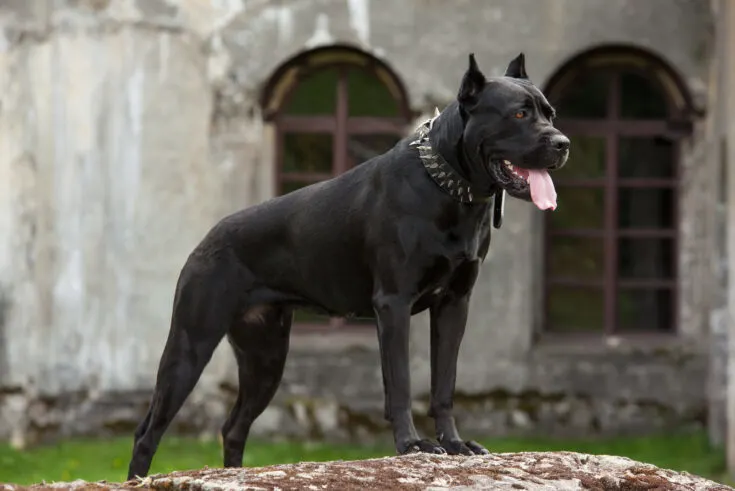
Unfortunately, canine epilepsy is a prevalent health problem in Cane Corsos.
Affected dogs may display bizarre behaviors such as spinning in circles, collapsing to the floor, looking blankly ahead, and eventually convulsing and jerking while drooling and biting.
Brain injuries, toxic shock, certain medications, etc., are just a few of the many potential triggers. The underlying reason is a neurological disorder.
Epilepsy of an idiopathic nature runs in families. Potential dog parents are routinely examined for this and other heritable disorders, and dogs with known health problems are kept out of breeding programs.
Because of this, it’s important to only get a dog from a reputable breeder.
What Should I Do If My Cane Corso Experiences an Epileptic Fit?
It may seem terrifying and heartbreaking now, but know that it is temporary.
The best course of action is to talk soothingly to your dog in order to ease its anxiety.
Your veterinarian will likely recommend anti-epileptics or anticonvulsants in addition to any other treatment he sees suitable.
If you suspect your dog has epilepsy, see a vet immediately. They’re powerful, and improper handling might hurt your dog.
Your dog’s convulsions might be a life-threatening sign that he or she has ingested something dangerous.
Primary epileptic seizures may be terrifying to see or experience firsthand, but they often resolve without lasting harm and respond well to therapy.
Some Common Questions
I am the sort that is never shy about asking several inquiries.
In most cases, the information provided will be valuable later on.
The reader may find the following information on the Mastiff breed to be of interest.
How long does a typical Cane Corso live?
The lifespan of a dog decreases in direct proportion to its size.
Even though it’s not right, Cane Corsos usually only live to be around 12 years old.
Just a little bit too short.
Every moment spent with your dog should be treasured since they are fleeting.
It’s a great emotion to provide joy to another person. Wonderful and lasting memories are made when you and your dog spend time together.
My Cane Corso Is Skin and Bones, What Gives?
The ribs of these Mastiffs protrude and the abdominal muscles are toned because of the breed’s innate leanness. It’s possible you’re making up these scary thoughts in your anxious head.
You should probably take your dog to the doctor if you’re worried about its unusually thin condition.
Does your dog get frequent worming treatments? Do you know whether it eats, or if it just seems disinterested in food? In order to maintain its peak physical condition, some owners choose to give their Cane Corso a raw food diet.
Your dog may not get enough to eat if it has a parasite such a tapeworm.
That’s a lot of wasted dog food.
The persistent refusal to eat might be due to an ulcer or an attack of acid reflux.
This avid eater seldom shows signs of not wanting to gorge itself at any time of day.
When it comes to disease, could Cane Corsos pose a threat to their owners?
Zoonotic illnesses are those that may be transmitted to people by many means, including the air, direct touch, saliva, etc. Neither the Cane Corso nor any other dog breed is an exception to this rule.
When taking your dog to the dog park, make sure he or she is up-to-date on vaccinations (rabies, distemper, etc.), free of fleas and ticks, and well-cared for.
The thing your dog brought in might very well turn on you next.
To put it to one side, in the present day and age? Not really, anyhow. Hopefully, everything will work out for you.
Is it a good idea to have a Cane Corso if I don’t have pet insurance?
Not something I’d worry about night after night. Problems with the Cane Corso’s health are typical for dogs in general. Regarding hereditary illnesses, I’d venture to say they’re quite lucky.
They’re a tough group that probably won’t slow down for anything, no matter what happens, and won’t take any sick days or vacation.
Do what you know is right in your heart, and don’t allow anything like pet insurance get in the way.
The ability to access it is invaluable. Having this on hand is always a good idea, but it’s particularly useful when dealing with a restless and naughty puppy.